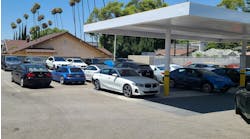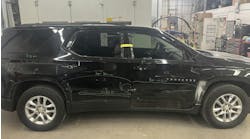For many shop owners and managers, the paint shop is one area with the greatest potential for profit improvement. There are several areas every shop can concentrate on and, with some effort and perseverance, create programs to dramatically boost profits.
Labor sales vs. labor cost
Simply put, this measurement is the cost of what you pay your techs to do a repair operation, compared to what you charge for that operation. It sounds simple enough but becomes complex when deciding which of the many available methods you should use to pay your technicians. Salary, hourly, flat rate and commission-based pay plans are the most common.
When paying by any of the above methods, you will need to measure your tech’s efficiency in order to determine whether or not he or she is producing at a profitable level. Your tech’s efficiency is based on hours produced compared to hours worked. As an example, your salaried or hourly tech produced 60 billable hours, in one 40-hour week. This translates into a 150 percent efficiency rate (hours produced are one and a half times hours worked, which is pretty standard in the industry). Compare what you made on those 60 billable hours to the salary paid to determine your profit percentage. Remember, this is gross profit, and doesn’t include benefit costs and taxes. If your tech is below the 150 percent rate, look into the reasons for the shortfall, and provide training and direction to improve the tech’s performance. When paying by flat-rate or commission, it’s much easier to maintain a specific level of profit on labor simply because you control the profit percentage on every hour produced, regardless of efficiency.
Simply put, if you pay your tech 40 percent commission, you are guaranteeing a 60 percent profit margin on labor. Many shops will start a technician off at a lower commission percentage and increase the percentage as the tech’s efficiency increases. For example:
- From 0-40 hours booked, your tech will earn 34 percent commission
- From 41-60 hours booked, your tech will earn 35 percent commission
- From 61-80 hours booked, your tech will earn 37 percent commission
- From 81-100+ hours booked, your tech will earn 40 percent commission.
This type of pay plan gives your tech the incentive to book more hours, produce more work and guarantees your lowest possible labor profit potential to be 60 percent.
Monitoring efficiency and making necessary corrections to improve it will pay great dividends.
Paint and material profit vs. cost
Keep in mind you cannot improve in any area without measuring your performance. This is true with any of the criteria mentioned earlier. You must make an effort to keep and maintain good records. A management system will help produce all of these reports with ease, but if you don’t have one, make a chart or spreadsheet to calculate and record these criteria.
There are several schools of thought on what the percentage of materials profit should be. Your supplier should be able to give you input in this area. Every paint manufacturer has a base number they use as the “correct” number for profit. In general, your costs for material should be somewhere between 3 percent and 8 percent of your total sales for the month, including all material, sandpaper, paint, tape, etc. Your actual profit margin can be calculated by cost vs. sales very easily. Many times, our sales on material are dictated by the allowable charges through our repair agreements. Essentially, by keeping your cost at the correct percentage, you will be able to manage your profit. This can be done daily by looking at your material invoices as they arrive, compared to your sales. If the percentage is high as you progress through the month, cut back on purchases (buy and use only what you need) to bring it back in line.
With the help of your jobber or supplier, develop a consolidated inventory of material you use in your shop. This inventory should include sandpaper, tape, masking paper, paint, solvent, primers, etc. Once developed, do not allow materials outside of your list to be purchased by your staff. This helps maintain repair consistency and control costs.
Issue every tech a specific inventory of material to keep in a personal cabinet or tool locker. All other material is locked in a safe and secure spot, which is maintained at a specific level, depending on your volume and staff size. Your jobber again can help develop this inventory. When a tech needs a roll of DA paper, he or she would then requisition the material from someone entrusted to monitor the secure inventory (e.g., shop manager or parts manager) using a form developed for this purpose. He/she would then sign for the material issued. Using this method, you can monitor specific employee habits and reduce waste. Your supplier would then maintain your standard inventory, during daily visits to your shop.
Proper estimating techniques
A poor estimate will cost you greatly. Make sure your estimate covers all necessary refinish operations. If a panel needs blending, make certain your estimate reflects it. Often, a vehicle will be properly repaired in the shop, but all the labor performed will not appear on the estimate, and, therefore, won’t be charged for. Make certain when inner panels are painted they are listed. Naturally, adhere to your guidelines when working with a direct repair program, but be cognizant that a poorly written estimate will cost plenty—not only in missed charges but also in lower cycle times caused by supplemental damage found that delays the repair. Again, training, communication and mentoring will help in this area.
Shop layout and organization
How your paint shop is situated in your building, how clean and functionally organized it is, plays a large part in your shop’s profitability. It should follow a smooth and unbroken workflow from body to paint, then back to body for re-assembly when painting is done. Disorganized, dirty and cluttered work areas will slow down production tremendously. A highly organized and efficient team is what you’re after. Look at your shop daily as if you were seeing it for the first time. You will be amazed at what you see that needs correcting. Again, use your jobber’s paint rep for help in your shop layout. They can really help most shops improve workflow and solve many common problems.
Redo or comeback ratio
Obviously, if you are re-doing work, you are losing material profit. Not only that, your techs are not producing profit-generating work when they are working on comebacks, so you are losing twice. Investigate the reasons work is being done over, and resolve the issues. If training is needed, provide it. It will cost you less in the long run. If you have an irreparable issue with a tech, part ways. Poor quality will cost you in real dollars and future dollars by losing potential customers due to a sagging reputation.
Proper hazardous waste handling
Refinish operations generate a large volume of waste products on a normal basis. Inaccurate paint mixing and over-pours will cost thousands per year in wasted material. This waste also must be removed very carefully following state and federal guidelines, which will cost you again. In essence, you’re paying twice when a mistake is made. This may sound repetitive, but get your paint suppliers involved in training your staff on proper mixing techniques. All manufacturers have certification and training programs that will help train your people to properly use their products. Enroll everyone you can. Use your mixing system reports to pinpoint employees who are making mistakes and get them extra training.
Lastly, consider a solvent recycling system. Throughout the course of a year, you will save a considerable amount of money on both thinner purchases and hazardous waste removal by doing so. These systems can be purchased or leased from several outside sources. Each option has benefits depending on your shop size and location. Investigate these options and decide which will work best for you—either will save you plenty.
As mentioned at the start of this article, these are the most common areas for improvement. There are numerous other KPI measurements that can be fine-tuned to help make your shop profits grow. However, if you follow these basics, you will be well on your way to happier customers, better insurance relationships and more cash in your pocket each month.




